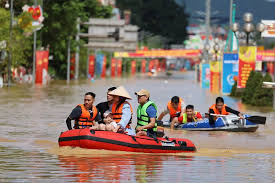Typhoon Matmo, locally known as Paolo, has caused widespread destruction across the Philippines and Vietnam, resulting in at least 39 confirmed deaths and significant property damage. Making landfall in early October, the storm brought heavy rains, strong winds, and severe flooding to multiple regions.
Impact in the Philippines
Several provinces reported submerged roads, collapsed bridges, and damaged homes. Emergency services have been conducting rescue operations, with many residents evacuated to temporary shelters. Authorities warned of the risk of landslides in mountainous areas, as persistent rainfall continues to saturate the soil.
Impact in Vietnam
Vietnam’s coastal and low-lying areas experienced severe flooding. Rivers overflowed, displacing thousands of people. Transportation networks were disrupted, with roads and rail lines damaged, complicating relief efforts. Local authorities have mobilized teams to assist affected communities.
Emergency Response and Relief Efforts
Government agencies in both countries deployed emergency response teams, including military personnel and volunteers, to carry out rescues and distribute aid. Food, medical supplies, and temporary housing are being provided to impacted communities, while authorities continue assessing the full scale of damage.
Meteorological Observations
Meteorologists noted that Typhoon Matmo intensified rapidly as it traversed the South China Sea, highlighting Southeast Asia’s vulnerability to extreme weather events during the typhoon season. Officials have urged residents to stay vigilant, follow evacuation orders, and avoid flooded or landslide-prone areas.
Aftermath and Recovery
Thousands remain without electricity, clean water, and access to essential services. Recovery efforts are expected to take weeks, as damaged infrastructure and homes require urgent repair. Both the Philippines and Vietnam governments have pledged continued support to help citizens rebuild and recover from the storm’s economic and social impacts.

